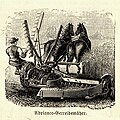Draft:Self-rake reaper
| Submission declined on 13 September 2024 by Timtrent (talk). Thank you for your submission, but the subject of this article already exists in Wikipedia. You can find it and improve it at Reaper#Mechanical reapers in the U.S. instead.
Where to get help
How to improve a draft
You can also browse Wikipedia:Featured articles and Wikipedia:Good articles to find examples of Wikipedia's best writing on topics similar to your proposed article. Improving your odds of a speedy review To improve your odds of a faster review, tag your draft with relevant WikiProject tags using the button below. This will let reviewers know a new draft has been submitted in their area of interest. For instance, if you wrote about a female astronomer, you would want to add the Biography, Astronomy, and Women scientists tags. Editor resources
|  |
The self-rake reaper (also grain reaper) was a harvesting machine (drawn by horses or oxen) for the grain harvest. It was the precursor to the self-binder (reaper-binder) or combine harvester. The rotating wings ensured that the cut grain did not fall forward in the direction of movement, but backwards.[1][2][3][4] At the same time, the grain was deposited in portions. Harvest workers following behind, mostly women, then had to bundle, bind and set up the sheaves. This technology originated in the USA around 1840.
History
[edit]The Virginia Reaper was patented in 1834 after the 22-year-old Cyrus McCormick developed a grain sheaf reaper in 1831. The workshop moved to Chicago in 1847 and delivered over 1,500 units by 1849. In 1851, this mower was shown at the first World Exhibition in London. [5] [6]
-
reaper "New Reaper"
-
"Adriance-Getreidemäher"
-
self-rake reaper of McCormick Germany (1936)
-
grain harvest in thuringia/germany – ca. 1950
See also
[edit]References
[edit]- ^ Ankli, Robert E. (1976). "The Coming of the Reaper". Business and Economic History. 5: 1–24. ISSN 0894-6825. JSTOR 23702777.
- ^ Jarchow, Merrill E. (1943). "Farm Machinery of the 1860's in Minnesota". Minnesota History. 24 (4): 287–306. ISSN 0026-5497. JSTOR 20162631.
- ^ Lerner, Eugene M. (March 1956). "Investment Uncertainty During The Civil War—A Note On The McCormick Brothers". The Journal of Economic History. 16 (1): 34–40. doi:10.1017/S0022050700064846. ISSN 1471-6372.
- ^ Pomfret, Richard (June 1976). "The Mechanization of Reaping in Nineteenth-Century Ontario: A Case Study of the Pace and Causes of the Diffusion of Embodied Technical Change". The Journal of Economic History. 36 (2): 399–415. doi:10.1017/S0022050700081742. ISSN 1471-6372.
- ^ "Daisy Self-Rake Reaper, circa 1895". National Museum of American History. Retrieved 2024-01-18.
- ^ McCormick company history: McCormick Harvesting Machine Company




